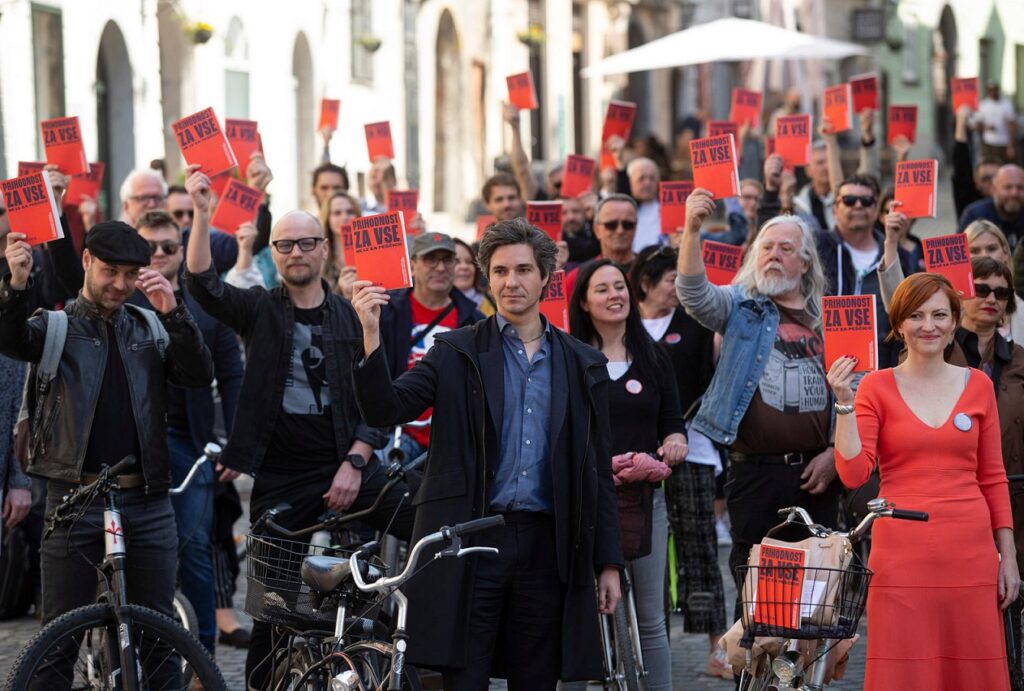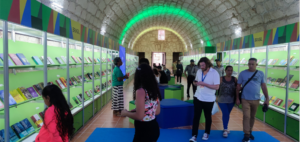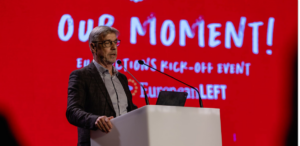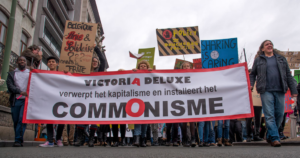The Left (Levica) has now been a member of the government for more than a year and a half. Besides this small left-wing party, the ruling coalition consists also of the centrist Freedom Movement and Social Democrats.
Ideological shifts and political fallout
Nonetheless, from today’s vantabe point it seems as if the only socialist party in the Slovenian parliament had absolutely no other choice but to join a centrist coalition led by liberal Prime Minister Robert Golob, even though two other coalition partners have a parliamentary majority also without The Left.
The reasons for this “unholy alliance” go back to the time of the far-right government of Janez Janša. Bourgeois liberal critics often accuse The Left and its leader Luka Mesec of enabling Janša’s return to power in 2020. The fact is that after the 2018 elections, The Left supported Marjan Šarec’s previous minority government in exchange for a few minor progressive policies written into the coalition agreement. Unsurprisingly, the centrist coalition soon broke with all agreements and political concessions, and The Left then chose to end political support for a patently neoliberal government. However, this did not lead to snap elections right away. The minority government still continued to function for a few months, until the prime minister surprisingly stepped down, as he mistakenly assumed that his resignation would be followed by new elections. But things did not turn out this way. Two centrist parties from Šarec’s coalition chose to support Janez Janša’s new right wing government rather than face a likely electoral decline. After that, the liberal public and media blamed The Left as being principally responsible for this course of events, and apparently, even many leftists accepted this interpretation. The result was a political realignment with previous liberal partners.
The Left, led by Luka Mesec, increasingly aligned itself with the other opposition parties in the so-called “constitutional arch coalition”, which loudly opposed corruption and authoritarianism and even more loudly advocated for the rule of law, the culture of dialogue, and everything else that is sacred in liberal democracy, which the opposition bloc, with no exceptions, was united in supporting. During TV debates, one no longer saw any ideological difference between socialist Luka Mesec and the other liberals. Almost only ideologocal point of the united oppostion was fighting Janez Janša. Allready a decades ago this type of politics gave rise to so called »anti-Janshism« which is practically the sole essence of centrist liberal parties in Slovenia regardless of whether Janša led the government or was in the opposition.
Electoral setback and internal turmoil
After the 2022 elections, the right-wing government was finally defeated, but at great cost for socialists. The Left, with 4.4 percent, fell to a little more than half of its previous result and thus became completely redundant in the new government, as the other two bourgeois parties had a majority in parliament even without the smallest parliamentary party. Nevertheless, The Left managed to introduce some progressive policies in the coalition agreement, such as the fight against the commercialisation and privatisation of healthcare, ending the arms deals made by the former government, the launch of public housing, and the fight against airbnbsation, along with greater regulation of the housing market, progressive property taxation, the gradual abolition of precarious work, and more. But after a year and a half, we can see today (again, to no one’s surprise) that the coalition agreement is not really being implemented. Instead, the government has already accelerated the privatisation of healthcare in its first few months, and further militarisation under the current government has reached previous levels. In the budget for 2024, the government is planning to spend almost twice as much on the military as the right-wing government spent on it in 2020. The Left ministers voted against this proposal but nevertheless surrendered to the government majority without a fight or at least without any minor threat of leaving the government. The Left has thus slowly become what it once most despised – a modern social democratic party.
Leadership transition and the path forward
But the party’s shift towards liberalism did not go unanswered. A large part of the membership had long been critical of this kind of political move. So before the party congress in June 2023, a group of socialist activists organised themselves and stood united in the party council elections on a platform of moving the party back to the left. The leader of the so-called “left wing” was Miha Kordiš, a former presidential candidate and an MP who, for years now, has been known for his firm socialist stances. Against all expectations, the “left wing” swept aside many representatives of the party leadership at the June congress. Miha Kordiš received the most votes at the congress from party members, while Mesec came in only fourth. Consequently, he stepped down after nearly a decade in charge.
The party leadership had underestimated their opponents and, at first, prepared for the elections in a rather disorganised way but subsequently avoided thismistake. In the next round, the opponents of the “left wing” consolidated their support for the Minister of Culture, Asta Vrečko, who, unlike Mesec, did not meet with such strong political disapproval among a large part of the membership. The main left-liberal newspaper Mladina and other mainstream media also joined in the fight against the internal opposition, depicting Kordiš and the left wing as factionalists and dangerous extremists.
The long and complicated election process only ended in September when the local committees, in the last round of elections, finally chose Asta Vrečko as the party’s new coordinator. Brief expectations of a political turn in the party were thus averted, at least for a while.
The path forward – reclaiming socialist identity
Despite the defeat of internal opposition, the right-wing factions’s consolidation of power was only partial. The left-wing, which had previously been unorganised and did not occupy positions in the party’s executive bodies in any significant numbers, has now established itself as a relevant political force and a counterweight inside the party apparatus. The left-wing activists now had the opportunity to try and organise a socialist workers’ movement in coexistence with the old-new leadership and to revive a terrain that the party had largely abandoned at a time when it mostly relied solely on electoral logic and contact with people through social networks and rather hostile mainstream media.
While the left wing has never advocated leaving the government, many socialists nevertheless see entry into government as a strategic mistake. To a liberal government and the capitalist class, The Left is much more dangerous in opposition, where it would be able to protest loudly against the neoliberal and militarist policies. The bourgeois bloc has much more easily eliminated the threat of an anticapitalist left by absorbing it into its own ranks. Allying yourself with an enemy to defeat an even worse enemy may be legitimate in some historical circumstances, but the fact is that right now this is not the case for socialists in Slovenia. The project of moving the party back to the left is an extremely difficult task that sadly does not have very many models that we can look to. Nevertheless, the survival of The Left as an anti-systemic alternative to capitalism depends, to a large extent, on left-wing activists and their organisational capacities to eventually move the party back to a socialist perspective without breaking it apart.



